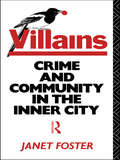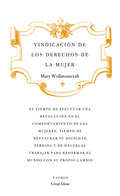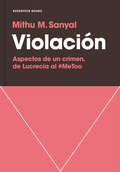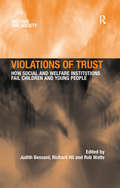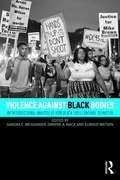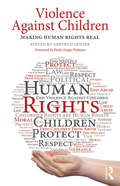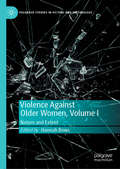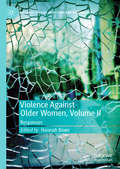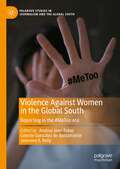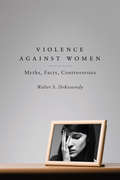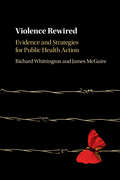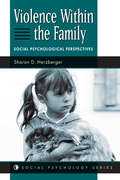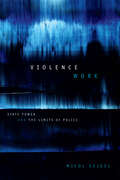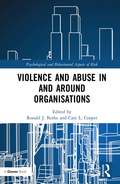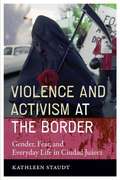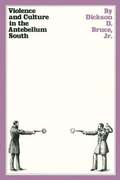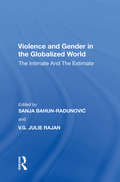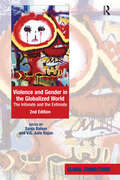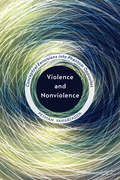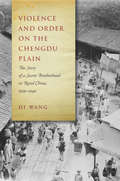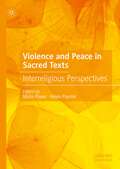- Table View
- List View
Villains - Foster
by Janet Foster"Villians" provides a rare insight into local and family traditions of petty crime. It looks at attitudes to crime and law enforcement, and the relationship of those attitudes to the culture in which they are expressed. This book should be of interest to students and teachers in police studies, ethnomethodology and women's studies.
Vindicación de los derechos de la mujer (Serie Great Ideas #Volumen 19)
by MARY WOLLSTONECRAFTIdeas que han cambiado el mundo. A lo largo de la historia, algunos libros han cambiado el mundo. Han transformado la manera en que nos vemos a nosotros mismos y a los demás. Han inspirado el debate, la discordia, la guerra y la revolución. Han iluminado, indignado, provocado y consolado. Han enriquecido vidas, y también las han destruido. Taurus publica las obras de los grandes pensadores, pioneros, radicales y visionarios cuyas ideas sacudieron la civilización y nos impulsaron a ser quienes somos. Esta apasionada declaración de independencia de la mujer escrita por Mary Wollstonecraft hizo añicos el estereotipo de la dama dócil y ornamental, anticipando una nueva era de igualdad y consagrando a su autora como fundadora del feminismo moderno. Comentarios sobre la colección Great Ideas:«De veras que la edición es primorosa y pocas veces contenido y continente pueden encontrarse mejor ensambladosy unidos. ¡Qué portadas! Para enmarcar. [...] Ante las Great Ideas, solo cabe quitarse el sombrero. ¡Chapeau!»ABC «Taurus propone un doble envite con este lanzamiento. Por un lado aumenta su compromiso con el ensayo; por otro, recupera el gusto por la estética. A los volúmenes se les ha proporcionado una portada delicada y cuidada (copian el original británico) que invita a la lectura.»La Razón «Un fenómeno editorial.»The Guardian «Aparte de los contenidos, en general muy bien elegidos, son tan bonitos que si los ven seguro que cae alguno.»El País «Ideas revolucionarias, crónicas de exploraciones, pensamientos radicales vuelven a la vida en estas cuidadísimas ediciones, muy atractivas para nuevos lectores.»Mujer Hoy «Grandes ideas bien envueltas. De Cicerón a Darwin, esta colección entra por los ojos.»Rolling Stone «Original y bella iniciativa la emprendida por Taurus con su colección Great Ideas.»Cambio 16 «Hay libros inmortales, libros únicos que contienen pensamientos y reflexiones capaces de cambiar el mundo, tesoros en miniatura reagrupados en la colección Great ideas.»Diario de León
Vindicación de los derechos de la mujer (Tribuna Feminista Ser. #Vol. 18)
by MARY WOLLSTONECRAFT«No deseo que las mujeres tengan podersobre los hombres, sino sobre sí mismas.» Una nueva edición que incluye el prólogo de Nuria Varela. El término feminismo no existía cuando Mary Wollstonecraft escribió este libro, que fue, sin embargo, la primera gran obra de la literatura feminista. En una época en la que la defensa de los derechos humanos había llevado la revolución a América y a Francia, Mary Wollstonecraft produjo su propia declaración de independencia en 1792. Vindicación de los derechos de la mujer atacó la idea dominante de una feminidad dócil y decorativa, y sentó los principios de la emancipación femenina. En estas páginas encontrarás la esencia de sus ideas, a favor de la educación de las mujeres y de su contribución a la sociedad. Racionalista y revolucionaria a la vez, y sin más poder que su pluma, Mary Wollstonecraft puso en marcha el movimiento que cambiaría el mundo para siempre y que, más de dos siglos después, continúa transformándolo. Prólogo de NURIA VARELA Traducción de MARTA LOIS GONZÁLEZ Comentarios sobre la colección Great Ideas:«De veras que la edición es primorosa y pocas veces contenido y continente pueden encontrarse mejor ensamblados y unidos. ¡Qué portadas! Para enmarcar. [...] Ante las Great Ideas, solo cabe quitarse el sombrero. ¡Chapeau!»ABC «Taurus propone un doble envite con este lanzamiento. Por un lado aumenta su compromiso con el ensayo; por otro, recupera el gusto por la estética. A los volúmenes se les ha proporcionado una portada delicada y cuidada (copian el original británico) que invita a la lectura.»La Razón «Un fenómeno editorial.»The Guardian «Aparte de los contenidos, en general muy bien elegidos, son tan bonitos quesi los ven seguro que cae alguno.»El País «Ideas revolucionarias, crónicas de exploraciones, pensamientos radicales vuelven a la vida en estas cuidadísimas ediciones, muy atractivas para nuevos lectores.»Mujer Hoy «Grandes ideas bien envueltas. De Cicerón a Darwin, esta colección entra por los ojos.»Rolling Stone «Original y bella iniciativa la emprendida por Taurus con su colección Great Ideas.»Cambio 16 «Hay libros inmortales, libros únicos que contienen pensamientos y reflexiones capaces de cambiar el mundo, tesoros en miniatura reagrupados en la colección Great ideas.»Diario de León
Vinyl: The Analogue Record in the Digital Age
by Ian Woodward Dominik BartmanskiRecent years have seen not just a revival, but a rebirth of the analogue record. More than merely a nostalgic craze, vinyl has become a cultural icon. As music consumption migrated to digital and online, this seemingly obsolete medium became the fastest-growing format in music sales. Whilst vinyl never ceased to be the favorite amongst many music lovers and DJs, from the late 1980s the recording industry regarded it as an outdated relic, consigned to dusty domestic corners and obscure record shops. So why is vinyl now experiencing a ‘rebirth of its cool’?Dominik Bartmanski and Ian Woodward explore this question by combining a cultural sociological approach with insights from material culture studies. Presenting vinyl as a multifaceted cultural object, they investigate the reasons behind its persistence within our technologically accelerated culture. Informed by media analysis, urban ethnography and the authors’ interviews with musicians, DJs, sound engineers, record store owners, collectors and cutting-edge label chiefs from a range of metropolitan centres renowned for thriving music scenes including London, New York, Tokyo, Melbourne, and especially Berlin, what emerges is a story of a modern icon.
Violación: Aspectos de un crimen, de Lucrecia al #MeToo
by Mithu M. SanyalUna mirada atrevida y honesta a la manera en que hablamos y pensamos sobre la violación. En la era del #yotecreo, el #metoo y el #timesup, examinar la cultura de la violación está en el centro de la agenda feminista. La crítica cultural Mithu Sanyal retoma el asunto donde lo dejó Susan Brownmiller en el clásico Contra nuestra voluntad (1975). De hecho, argumenta que la manera en que entendemos la violación apenas ha variado desde entonces, a pesar de que el mundo sí ha cambiado por completo. Defiende que ha llegado el momento de abrir un debate nuevo e informado sobre la violación, la vulnerabilidad y los límites del consentimiento. Sanyal aduce que el modo en que concebimos la violación no nos dice solo como entendemos la violencia sexual, sino cómo entendemos el sexo, la sexualidad y el género. Por ejemplo, ¿por qué es tan difícil imaginar a los hombres como víctimas de una violación? ¿Por qué esperamos de las víctimas que actúen como si sus vidas hubieran sido irreversiblemente destrozadas? Cuando pensamos en los violadores, ¿por qué seguimos pensando en extraños en callejones oscuros y no en tíos, maridos, sacerdotes o novios? Con un enfoque provocador, Sanyal toma todas las ideas preconcebidas y les da la vuelta para exponer las estructuras invisibles que controlan el pensamiento de conservadores, progresistas, machistas o feministas.
Violations of Trust: How Social and Welfare Institutions Fail Children and Young People (Welfare and Society)
by Richard HilThe past few decades have brought to light increasing evidence of systemic and repeated institutional abuse of children and young people in many western nations. Government enquiries, research studies and media reports have begun to highlight the widespread nature of sexual, physical and emotional abuse of vulnerable children and young people. However, while public attention has focused on 'episodic-dramatic' representations of institutional abuse, comparatively little emphasis has been given to the more mundane, routinized and systemic nature of abuse that has occurred. This book documents comprehensively a full range of abuse occurring in 'caring' and 'protective' institutions, with particular reference to the Australian case. The dominant theme is 'betrayal' and in particular the ways in which agencies charged with the care and protection of children and young people become the sites of abusive practices. The authors draw on a range of theoretical frameworks to explore issues of trust and betrayal in the context of the professional and ethical obligations which workers have to those in their charge. The authors argue that it is not sufficient merely to report on accounts of institutional abuse or the consequences of particular practices; rather it is necessary to locate the prevalence of institutional abuse in the wider context of institutional practices as they relate to the 'governance' of particular sections of the population.
Violence Against Black Bodies: An Intersectional Analysis of How Black Lives Continue to Matter
by Elwood Watson Dwayne A. Mack Sandra E. WeissingerViolence Against Black Bodies argues that black deaths at the hands of police are just one form of violence that black and brown people face daily in the western world. Through the voices of scholars from different academic disciplines, this book gives readers an opportunity to put the cases together and see that violent deaths in police custody are just one tentacle of the racial order—a hierarchy which is designed to produce trauma and discrimination according to one’s perceived race and ethnicity.
Violence Against Children: Making Human Rights Real
by Paulo Sérgio Pinheiro Gertrud LenzerViolence Against Children adopts in its title the exhortation of Nobel Laureate Amartya Sen, "Making Human Rights Real," which also represents the leitmotif of the book. It examines the prevalence of violence against children in Africa, the Asia Pacific Region, Europe, Latin America and the Caribbean, and in the United States, and explores major ways of its prevention. Making human rights real engenders the challenge of helping all children to be free from violence and to lead a life replete with genuine nurture and the elimination of all violence. Only in this manner will the goal of the United Nations 2030 Agenda for Sustainable Development —target 16.2—be achieved and the child as a rights-bearing individual realized in her/his fullness. The specially commissioned chapters that make up the volume have been written by renowned scholars, researchers and advocates. They coalesce to provide an overview of the challenges facing children exposed to violence worldwide, and they advance discussions of the measures which are available and necessary for the prevention of violence against children. The book is intended for policy-makers, researchers and students of the social sciences and human rights who are interested in ending all the widespread maltreatment of children in our societies and our time.
Violence Against Older Women, Volume I: Nature and Extent (Palgrave Studies in Victims and Victimology)
by Hannah BowsThis book brings together international research from scholars and activists on the forms of violence that older women experience into a unique, comprehensive two-volume set. This first volume consolidates the research on the forms, causes and extent of different forms of violence against older women. It considers the theoretical limitations of our understandings and charts the gaps in empirical and theoretical research in this area and how this has hindered effective policy and practice responses to violence against older women. Taken together, this volume offers an important starting point from which future research can draw to address the gaps in knowledge and evidence. It also highlights issues that are particular to older women’s experiences of violence compared with younger women. It highlights gaps in existing research and suggests a future research agenda and implications for practitioners. It will be of interest to researchers in social and health care, gerontology, sociology and social policy, feminist research and criminology.
Violence Against Older Women, Volume II: Responses (Palgrave Studies in Victims and Victimology)
by Hannah BowsThis book brings together international research from scholars and activists on the forms of violence that older women experience into a unique, comprehensive two-volume set. This volume is concerned with understanding the consequences and impacts of violence against older women. The majority of policy and practice has been developed to reflect the dynamics and contexts of violence affecting young women, and most of the available support services had focused on the needs of those of child-bearing age. This volume sheds light on the specific needs and effectiveness of responses to violence against older women, and identifies both challenges and opportunities for developing services that meet older survivor's needs. It will be of interest to researchers in social and health care, gerontology, sociology and social policy, feminist research and criminology.
Violence Against Women in the Global South: Reporting in the #MeToo era (Palgrave Studies in Journalism and the Global South)
by Andrea Jean Baker Celeste González de Bustamante Jeannine E. RellyBringing together 14 journalism scholars from around the world, this edited collection addresses the deficit of coverage of violence against women in the Global South by examining the role of the legacy press and social media that report on and highlight ways to improve reporting. Authors investigate the ontological limitations which present structural and systemic challenges for journalists who report on the normalization of violence against women in country cases in Argentina; Brazil; Mexico; Indonesia; Kenya, Nigeria, South Africa; Egypt; Libya, Syria, and Yemen. Challenges include patriarchal forces; gender imbalance in newsrooms; propaganda and censorship strategies by repressive, hyper-masculine, and populist political regimes; economic and digital inequities; and civil and transnational wars. Presenting diverse conceptual, methodological, and empirical chapters, the collection offers a revision of existing frameworks and guidelines and aims to promote more gender-sensitive, trauma-informed, solutions-driven, and victim or survivor centered reporting in the region.
Violence Against Women: Myths, Facts, Controversies
by Walter S DeKeseredyIn Violence Against Women, award-winning author Walter S. DeKeseredy offers a passionate but well-documented sociological overview of a sobering problem. He starts by outlining the scope of the challenge and debunks current attempts to label intimate violence as gender neutral. He then lays bare the structural practices that sustain this violence, leading to a discussion of long- and short-term policies to address the issue. DeKeseredy includes an examination of male complicity and demonstrates how boys and men can change their roles. Throughout, he responds to myths that dismiss threats to women's health and safety and provides an impassioned call to action for women, men, and policymakers.
Violence Rewired: Evidence and Strategies for Public Health Action
by Richard Whittington James McGuireThis thought-provoking book draws together research from genetics, anthropology, psychology and the social sciences to show that widespread assumptions about the inevitability of human violence are almost entirely a collection of myths. While violence has been a recurring feature of human life, there is no reason to suppose that it is inherent in 'human nature'. On the contrary, patterns of aggressive behaviour are largely learned through experience and even those individuals who have often acted violently can learn to change. Rejecting the speculations of much contemporary writing about human aggression, Violence Rewired presents an evidence-based alternative: a multi-level model of action to reduce violence at both individual and collective levels, linked to public health initiatives developed by the World Health Organization. If humanity is to survive the challenges it faces, a more realistic appraisal of ourselves and our basic tendencies is an indispensable part of the solution.
Violence Within The Family: Social Psychological Perspectives
by Sharon D HerzbergerHerzberger connects the study of child, partner, sibling, and elderly abuse to the varied disciplinary perspectives of social psychology. She addresses aggression, the consequences of this type of violence, and prevention and treatment strategies. This book is appropriate for course use in criminal justice, family systems, public policy, psychology
Violence Work: State Power and the Limits of Police
by Micol SeigelIn Violence Work Micol Seigel offers a new theorization of the quintessential incarnation of state power: the police. Foregrounding the interdependence of policing, the state, and global capital, Seigel redefines policing as “violence work,” showing how it is shaped by its role of channeling state violence. She traces this dynamic by examining the formation, demise, and aftermath of the U.S. State Department's Office of Public Safety (OPS), which between 1962 and 1974 specialized in training police forces internationally. Officially a civilian agency, the OPS grew and operated in military and counterinsurgency realms in ways that transgressed the borders that are meant to contain the police within civilian, public, and local spheres. Tracing the career paths of OPS agents after their agency closed, Seigel shows how police practices writ large are rooted in violence—especially against people of color, the poor, and working people—and how understanding police as a civilian, public, and local institution legitimizes state violence while preserving the myth of state benevolence.
Violence and Abuse In and Around Organisations (Psychological and Behavioural Aspects of Risk)
by Cary L. Cooper Ronald J. BurkeThis international collection examines violence and abuse in and around organisations. The collection documents the causes, specifically from the perspective of human relations and of the workplace conditions. It also highlights the specific risks associated with high-risk professions or working environments. The first section considers types of violence and abuse, their relative frequencies, potential individual and workplace antecedents, costs to individuals, family’s organisations and societies, the fact both are increasing in frequency with new types (e.g., terrorism) appearing, and why addressing these has become increasingly important for individuals and organisations. The second section considers violence in interpersonal relationships such as bullying, incivility, bias and harassment, and toxic leadership. The third section examines unsafe workplaces, accidents, injuries, and deaths. The fourth section considers exploitive work conditions and arrangements such as precarious employment, the exploitation of immigrants, and human slavery. The final section offers suggestions on ways to address violence and abuse in and around organisations. These include aggression preventative supervisor behaviours in health care, suicide prevention in the workplace, dealing with disgruntled employees and former employees, and workplace interventions that address stress reduction more broadly. As with other titles in the Psychological and Behavioural Aspects of Risk Series, this research-based collection is firmly grounded in the boundary between work and society and offers important insights into how social and cultural problems are manifest in the workplace and how poor and abusive workplace practice, in turn, spills out into wider life.
Violence and Activism at the Border
by Kathleen StaudtBetween 1993 and 2003, more than 370 girls and women were murdered and their often-mutilated bodies dumped outside Ciudad Juárez in Chihuahua, Mexico. The murders have continued at a rate of approximately thirty per year, yet law enforcement officials have made no breakthroughs in finding the perpetrator(s). Drawing on in-depth surveys, workshops, and interviews of Juárez women and border activists, Violence and Activism at the Border provides crucial links between these disturbing crimes and a broader history of violence against women in Mexico. In addition, the ways in which local feminist activists used the Juárez murders to create international publicity and expose police impunity provides a unique case study of social movements in the borderlands, especially as statistics reveal that the rates of femicide in Juárez are actually similar to other regions of Mexico. Also examining how non-governmental organizations have responded in the face of Mexican law enforcement's "normalization" of domestic violence, Staudt's study is a landmark development in the realm of global human rights.
Violence and Culture in the Antebellum South
by Dickson D. Bruce Jr.This provocative book draws from a variety of sources-literature, politics, folklore, social history-to attempt to set Southern beliefs about violence in a cultural context. According to Dickson D. Bruce, the control of violence was a central concern of antebellum Southerners. Using contemporary sources, Bruce describes Southerners' attitudes as illustrated in their duels, hunting, and the rhetoric of their politicians. He views antebellum Southerners as pessimistic and deeply distrustful of social relationships and demonstrates how this world view impelled their reliance on formal controls to regularize human interaction. The attitudes toward violence of masters, slaves, and "plain-folk"-the three major social groups of the period-are differentiated, and letters and family papers are used to illustrate how Southern child-rearing practices contributed to attitudes toward violence in the region. The final chapter treats Edgar Allan Poe as a writer who epitomized the attitudes of many Southerners before the Civil War.
Violence and Gender in the Globalized World: The Intimate and the Extimate (Global Connections Ser.)
by V. G. Julie Rajan Sanja Bahun-RadunovićViolence and Gender in the Globalized World expands the present discourse on gender and violence, discovering new ways to address the complexities encountered in academic research on the topic. Through the introduction of a variety of uncommonly discussed geopolitical sites and dynamics, the book redefines the critical picture of gender violence in the age of globalization, adopting diverse methodological approaches and various disciplinary praxes in its investigation of the question of violence against women across the globe. With an international team of contributors comprising both scholars and activists, this volume bridges the gap between academic and activist perspectives on gender violence. As such, it will be of interest to anyone conducting research in the areas of gender and sexuality, human rights, cultural studies, political science, history, postcolonialism and colonialism, sociology, anthropology, philosophy and religion.
Violence and Gender in the Globalized World: The Intimate and the Extimate (Global Connections)
by Sanja Bahun Rajan, V.G. JulieViolence and Gender in the Globalized World expands the critical picture of gender and violence in the age of globalization by introducing a variety of uncommonly discussed geo-political sites and dynamics. The volume hosts methodologically and disciplinarily diverse contributions from around the world, discussing various contexts including Chechnya, Germany, Iraq, Kenya, Malaysia, Nicaragua, Palestine, the former Yugoslavia, Syria, South Africa, the United States, and the Internet. Bringing together scholars’ and activists’ historicized and site-specific perspectives, this book bridges the gap between theory and practice concerning violence, gender, and agency. In this revised and updated edition, the scope of inquiry is expanded to incorporate phenomena that have recently come to the forefront of public and scholarly scrutiny, such as Internet-based discourses of violence, female suicide bombers, and the Islamic State’s violence against women. At the same time, new data and developments are brought to bear on earlier discussions of violence against women across the globe in order to bring them fully up to date. With an international team of contributors, comprising eminent scholars, activists and policy-makers, this volume will be of interest to anyone conducting research in the areas of gender and sexuality, human rights, cultural studies, law, sociology, political science, history, post-colonialism and colonialism, anthropology, philosophy and religion.
Violence and Non-Violence across Time: History, Religion and Culture
by Sudhir ChandraThis book probes the complex interweaving, across time and cultures, of violence and non-violence from the perspective of the present. One of the first of its kind, it offers a comprehensive examination of the interpenetration of violence and non-violence as much in human nature as in human institutions with reference to different continents, cultures and religions over centuries. It points to the present paradox that even as violence of unprecedented lethality threatens the very survival of humankind, non-violence increasingly appears as an unlikely feasible alternative. The essays presented here cover a wide cultural–temporal spectrum — from Vedic sacrifice, early Jewish–Christian polemics, the Crusades, and medieval Japan to contemporary times. They explore aspects of the violence–non-violence dialectic in a coherent frame of analysis across themes such as war, jihad, death, salvation, religious and philosophical traditions including Buddhism, Christianity, Judaism, Hinduism, Islam, mysticism, monism, and Neoplatonism, texts such as Ramayana, Mahabharata and Quran, as well as issues faced by Dalits and ethical imperatives for clinical trials, among others. Offering thematic width and analytical depth to the treatment of the subject, the contributors bring their disciplinary expertise and cultural insights, ranging from the historical to sociological, theological, philosophical and metaphysical, as well as their sensitive erudition to deepening an understanding of a grave issue. The book will be useful to scholars and researchers of history, peace and conflict studies, political science, political thought and cultural studies, as well as those working on issues of violence and non-violence.
Violence and Nonviolence: Conceptual Excursions into Phantom Opposites
by Peyman VahabzadehThrough an original and close reading of the key literature regarding both revolutionary violence and nonviolence, this book collapses the widely-assumed concepts of violence and nonviolence as mutually exclusive. By revealing that violence and nonviolence are braided concepts arising from human action, Peyman Vahabzadeh submits that in many cases the actions deemed to be either violent or nonviolent might actually produce outcomes that are not essentially different. Vahabzadeh offers a conceptual phenomenology of the key thinkers and theorists of both revolutionary violence and various approaches to nonviolence. Arguing that violence is inseparable from civilizations, Violence and Nonviolence concludes by making a number of original conceptualizations regarding the relationship between violence and nonviolence, exploring the possibility of a nonviolent future and proposing to understand the relationship between the two concepts as concentric, not opposites.
Violence and Order on the Chengdu Plain: The Story of a Secret Brotherhood in Rural China, 1939-1949
by Di WangIn 1939, residents of a rural village near Chengdu watched as Lei Mingyuan, a member of a violent secret society known as the Gowned Brothers, executed his teenage daughter. Six years later, Shen Baoyuan, a sociology student at Yenching University, arrived in the town to conduct fieldwork on the society that once held sway over local matters. She got to know Lei Mingyuan and his family, recording many rare insights about the murder and the Gowned Brothers' inner workings. Using the filicide as a starting point to examine the history, culture, and organization of the Gowned Brothers, Di Wang offers nuanced insights into the structures of local power in 1940s rural Sichuan. Moreover, he examines the influence of Western sociology and anthropology on the way intellectuals in the Republic of China perceived rural communities. By studying the complex relationship between the Gowned Brothers and the Chinese Communist Party, he offers a unique perspective on China's transition to socialism. In so doing, Wang persuasively connects a family in a rural community, with little overt influence on national destiny, to the movements and ideologies that helped shape contemporary China.
Violence and Peace in Sacred Texts: Interreligious Perspectives
by Helen Paynter Maria PowerThis volume brings together 11 experts from a range of religious backgrounds, to consider how each tradition has interpreted matters of violence and peace in relation to its sacred text. The traditions covered are Hinduism, Buddhism, Judaism, Christianity, Islam and Sikhism. The role of religion in conflict, war, and the creation of peaceful settlements has attracted much academic attention, including considerations of the interpretation of violence in sacred texts. This collection breaks new ground by bringing multiple faiths into conversation with one another with specific regard to the handling of violence and peace in sacred texts. This combination of close attention to text and expansive scope of religious inclusion is the first of its kind.
Violence and Social Orders
by Douglass C. North John Joseph Wallis Barry R. Weingast DOUGLASS C. NORTH JOHN JOSEPH WALLISAll societies must deal with the possibility of violence, and they do so in different ways. This book integrates the problem of violence into a larger social science and historical framework, showing how economic and political behavior are closely linked. Most societies, which we call natural states, limit violence by political manipulation of the economy to create privileged interests. These privileges limit the use of violence by powerful individuals, but doing so hinders both economic and political development. In contrast, modern societies create open access to economic and political organizations, fostering political and economic competition. The book provides a framework for understanding the two types of social orders, why open access societies are both politically and economically more developed, and how some 25 countries have made the transition between the two types.
